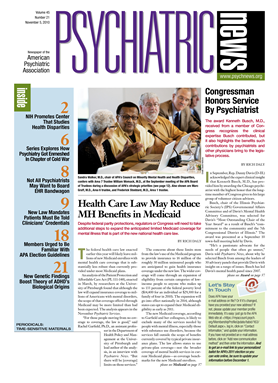Although many psychiatrists are well versed in the life of Sigmund Freud, few are probably cognizant that Freud and another figure who shaped the 20th century—Adolf Hitler—were neighbors in Vienna, Austria, from 1906 to 1913.
Yet they were, Manfred Becker, a German-born film director now working in Canada, reported at the Canadian Psychiatric Association annual meeting in Toronto in September, where he showed his documentary, “Neighbors: Freud and Hitler in Vienna” to an overflow audience.
Becker made the film for Canadian television in 2003. “That those men shared the same neighborhood for some time and dominated the 20th century was the focus of my film,” he said.
The film examines the philosophies and eerily parallel existences of these two men. Freud, a Jew, gave people knowledge of the unconscious, hoping to free them from their irrational instincts. Hitler unleashed those irrational instincts, planning to liberate the Germans from their perceived enemy, the Jews. The film contains a lot of original film footage of both men, as well as interviews with key sources, such as Freud's granddaughter Sophie Freud, who now lives in Boston.
Here are descriptions of some of the film's interesting scenes.
•.
It is 1907 Vienna. Hitler, a high-school dropout, has just buried his mother. The family doctor has noted that Adolf's attachment to his mother bordered on the pathological. Adolf's father, who had beaten him and his mother regularly and savagely, had already drunk himself to death with alcohol.
At this juncture, Hitler admires the Jewish people because of their extraordinary contributions to the arts and sciences and indicates that he wants to be a part of their culture. He expresses a wish be a painter and applies to Vienna's Academy of Fine Arts.
Freud takes his dog for walks on a square where Hitler also goes from time to time to buy magazines.
•.
1908: Hitler's application to the art academy is rejected. He becomes a drifter. Sometimes he enters the Austrian parliament to escape the cold. There he hears people blaming the Jews for the uncertain times. By candlelight Hitler sketches utopian cities. He organizes a small band of disaffected followers.
•.
1909: Some of Hitler's followers are Jewish. He lives in a boarding house located a few blocks from the house where Freud lives and works at 19 Berggasse. Freud, meanwhile, is a master of his own group of disciples, with Carl Jung declared “the crown prince.”
•.
1913: Hitler leaves Vienna.
•.
1920: Freud's daughter Sophie dies in the 1918-1920 flu pandemic.
•.
1923: Hitler has become head of the national socialist movement, commonly known as the Nazi party, and has written his manifesto, Mein Kampf. At this juncture he is aware of Freud's ideas and declares psychoanalysis an idea of a deranged mind. But Freud is apparently not aware of Hitler; he is uninterested in politics.
•.
1933: Hitler gains control of the German government.
•.
1938: Hitler returns to Austria as a “liberator.” Jung gives Freud money to escape Austria, but he refuses to do so. Then Freud's daughter Anna is picked up by Hitler's Gestapo. When she is released, Freud finally agrees to leave Austria. In June, he says goodbye to Vienna, which has been his home for 70 years. He and his family move to London. Freud's sisters remain in Austria, however, and die in concentration camps.
After Becker showed this film to the Canadian psychiatrists, poignant comments and heated conversation about it followed.
“As you know, I am from that place where Hitler was from—Germany,” Becker commented. “I was under the cloud of the Holocaust [as were all Germans in the years after World War II]. I thought I could escape that cloud in Canada. But then someone in the schoolyard called my son a Nazi. So in a sense this film was a form of self-psychotherapy for me.”
Said one psychiatrist: “Both Freud and Hitler had the experience of losing a parent, being traumatized by it, et cetera. I don't think that Hitler's childhood has ever been examined sympathetically.” To which Becker replied: “How do you sympathize with evil? For Germans it is very hard to go there.”
In the minds of others in the audience, the film raised questions that will probably never be answered. For instance, did Freud and Hitler ever encounter each other when they lived in the same neighborhood? Could they have ever greeted each other in a cordial manner? And if they had, might it have ameliorated Hitler's view of Jews? And suppose Hitler had been accepted into Vienna's Academy of Fine Arts to study painting. Would it have made him feel that he had been accepted into the cultural world of Jews and have deterred him from becoming disenchanted with Germany's condition and blaming that condition on Jews?
“The question of a possible and then fateful encounter between the two men is a big one,” Becker told Psychiatric News. “Of course I thought about that possibility.”
Becker has directed and written eight documentaries for television. His subjects have ranged from the life of a stage actor with schizophrenia to what it means to be a German living under the cloud of the Holocaust. He also teaches film at York University in Toronto.


